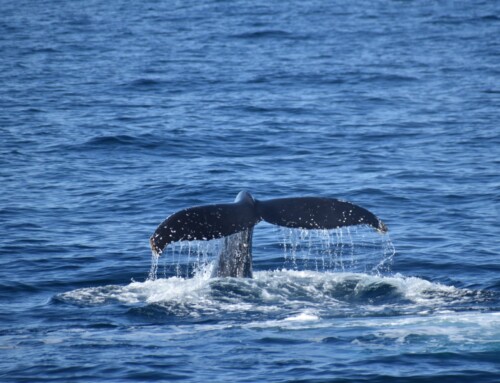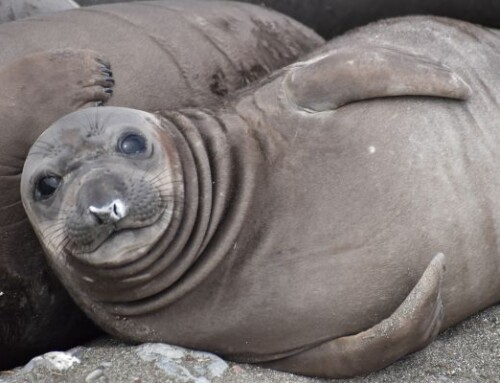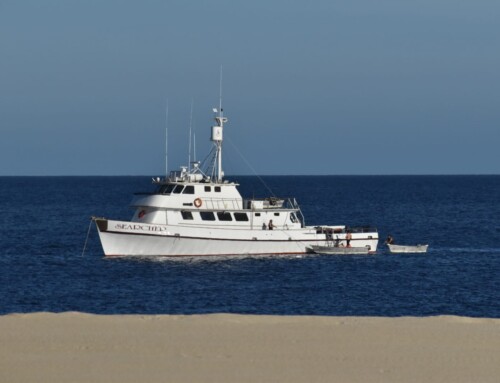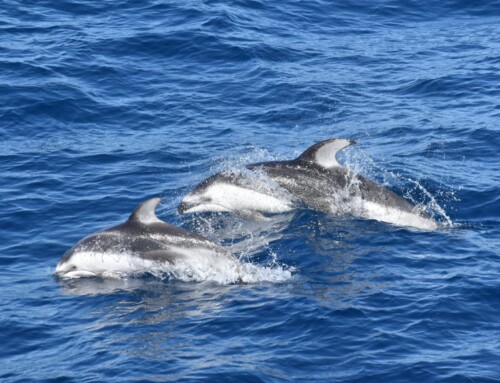DATE: September 5-9, 2005
TRIP: Offshore Birding Trip
Daily Journal
By Todd McGrath, Walter Wehtje and Don DesJardin
Day One: San Diego and points north.
After an orientation of the boat and an introduction of the leaders (Don DesJardin, Mary Gustafson, Todd McGrath and Walter Wehtje), we began our multi-day exploration of the waters off southern California. While still in San Diego Bay, ELEGANT TERNS a few ROYAL TERNS, and BROWN PELICANS were seen in good numbers. A stop at the bait barge yielded excellent looks at BRANDT’S CRMORANTS, SNOWY and GREAT EGRETS, as well as good numbers of HEERMAN’S and WESTERN GULLS. We also saw hundreds of CALIFORNIA SEA LIONS sprawled out on the barges, napping after taking advantage of the ample food source discarded sardines and anchovies provide.
As we continued out of the bay, bird numbers picked up, with large groups of migrating COMMON TERNS feeding over massive numbers of anchovies. The baitfish were close to shore and also attracted the attention of BROWN PELICANS and BRANDT’S CORMORANTS. After turning northwards we spotted three BLACK-VENTED SHEARWATERS sitting on the water. We made a short stop so everyone could get a good look at this near-shore species. Black-vented Shearwaters are just beginning to arrive in California in early Sept., so the eight recorded this first day were good finds. Our first of many RED-NECKED PHALAROPES were also seen flying by in small groups. Farther along the coast we saw more COMMON TERNS as well as our first PINK-FOOTED and SOOTY SHEARWATERS. Jaegers were well represented with a POMARINE and 2 PARASTIC JAEGERS, with a well-seen SOUTH POLAR SKUA added for good measure. Good numbers of BLACK and a single LEAST STORM-PETREL were spotted, but as is often the case, the LEAST STORM-PETREL was not seen well by all.
Marine Mammals were also well represented with sightings of NORTHERN ELEPHANT SEAL, BOTTLENOSE DOLPHIN, both SHORT-BEAKED and LONG-BEAKED COMMON DOLPHINS, as well as a pair of MINKE WHALES.
After a fine dinner, most of us headed off to bed early in anticipation of a busy second day. During the night the weather (which was beautiful our first day) began to worsen, with increasing wind and swell.
Day Two:
South of Santa Rosa Island, San Miguel Island, Cojo Anchorage
At dawn we were about halfway between Santa Rosa and San Nicolas Islands. Our plan was to work westward in order to explore several promising temperature breaks, including the area where North America’s first Hornby’s Storm-petrel had been observed in early August, and then head north to Pt Conception. This was our most challenging day weather-wise, as we needed to proceed into 15 mph wind and 4-6’ swells. The area we covered is often very productive, but after determining that the storm-petrel hadn’t stuck around, we turned north towards San Miguel Island at 0915. Despite the challenging viewing conditions we saw our first BLACK-FOOTED ALBATROSSES, SABINE’S GULLS, and LONG-TAILED JAEGERS, along with 6 SOUTH POLAR SKUAS. Our first BULLER’S SHEARWATERS were also a welcome sight, as this species is irregular in Southern California in early September.
At 1200 we reached San Miguel Island, where we anchored at Crook Point and ate lunch in sheltered waters. After giving everyone the opportunity to regain their sea legs, we lifted anchor at 1330 and headed west to see what we could find beyond San Miguel Island. As before, the birds were present, but hard to keep in view. We had a much easier time with a pair of HUMPBACK WHALES. One of them kept slapping its wing-like pectoral fins and tail flukes at the surface, making them visible from almost a mile away. After seeing our fill, we continued north, arriving at Cojo Anchorage near Pt. Conception in time for dinner. After enjoying the beautiful sunset and spectacular starry skies we went down to our bunks, and several hours of relaxing sleep.
Day 3:
South to the San Juan Seamount
At 0400 the “Searcher” left Cojo Anchorage. With the strong NW winds and 6-8’ swells, we decided to keep our course at 195 o to keep everyone comfortable. The water temperature was 57 o F, and we didn’t expect much until the waters warmed near the San Juan Seamount, 85 miles to our south. Around 0715, we hit a very rough patch of water that demarcated a shift in the water temperatures. The water rose up to 62.5 o F within a few miles, and just before 8AM Todd McGrath spotted the first COOK’S PETREL of the trip. We were less than 20 miles southwest of San Miguel Island in an area where we did not expect this species. A few people were still below deck so, while many got an excellent look at this bird, some missed it. Todd was particularly pleased to have found it, as it was his 800 th ABA area bird. Paul Sykes was less pleased, as he’d just been reassured that we were unlikely to see Cook’s Petrels for several more hours, and had gone down to his cabin for a spell.
Luckily, at lunchtime a second bird circled the boat and provided almost everyone with great looks. We would see another 4 COOK’S PETRELS before dark, several of which put on a show for us. By mid-afternoon we reached the San Juan Seamount, and the birding became excellent. Our first of 5 adult RED-BILLED TROPICBIRDS were seen here. Usually Red-billed Tropicbirds are closer inshore, and this was the first time we’ve found them beyond the continental shelf. The most unexpected sighting occurred while everyone was watching a Cook’s Petrel fly southwards parallel with the boat. Todd McGrath got on a dark pterodroma flying northwards, and recognized it as a MURPHY’S PETREL. Murphy’s Petrel is regular in spring, but there are very few records from other seasons. As we left the San Juan Seamount, our only NORTHERN FULMAR of the trip followed our wake for some time. This species is irruptive and 2005 has been a down year, with very few reported. We also saw small numbers of CASSIN’S AUKLETS as well as more BLACK-FOOTED ALBATROSSES. In this area our trolling effort gave result with two SKIPJACK tuna pulled aboard. We motored along until 2330, when the crew set the sea anchor (a large underwater parachute). The weather was still less than ideal, but most of us managed to sleep in spite of the rocking.
Day 4:
32° N, 120° 30’ W to Sixty-mile Bank
The birding day began at 0001. The boat’s lights brought in a variety of birds, and by 0030 hundreds of RED PHALAROPES had been by the boat, as well as a couple of COOK’S PETRELS. A few hardy individuals stayed out on deck until 0230. In that time they recorded hundreds, perhaps thousands of RED PHALAROPES, as well as dozens of RED-NECKED PAHALAROPES, 2 SABINE’S GULLS, 2 ARCTIC TERNS, and a total of 4 COOK’S PETRELS. One of these birds flew into the lights, circled the boat and landed on the water no more than 3 feet from Todd McGrath and two other night-owls. A circling WHIMBREL called repeatedly dropped into the lights, a strange sight more than 130 miles from shore.
At 0500, we began pouring out our chum slick in earnest, with high hopes. At 0620 an all-dark bird with a pale bill came into the boat. It was initially called a FLESH-FOOTED SHEARWATER by Mary Gustafson. Flesh-footed Shearwater is quite rare beyond the continental shelf and that far south, so Todd McGrath wanted to be sure to eliminate Parkinson’s Petrel (a bird reported several times for North America but not yet documented). The best separating feature is leg color, with Parkinson’s Petrel showing black legs as opposed to the pinkish legs that give Flesh-footed it’s name. In the low early morning light, leg color could not be discerned for certain, but Todd and Mary decided that other marks such as the overall brown coloration without a contrast with the head, size and shape of the bill, and overall structure and size supported Mary’s original ID as a Flesh-footed Shearwater. Walter Wehtje was troubled by what looked like the feet of the bird extending beyond the tail, reminiscent of a Black-footed Albatross, but decided that this was one of those birds one has to leave unidentified. As it got lighter, we had good looks at several RED-BILLED TROPICBIRDS, with 7 seen that day, bringing our total for the trip to an even dozen.
As we proceeded eastwards, we encountered the slowest birding of the trip. Normally this area is calm, allowing us to find birds on the surface some distance out. Unfortunately, an unseasonable pressure differential kept the winds at 15+ mph for most of the day, and we saw relatively few birds until we reached Sixty-mile Bank. Occasional LEACH’S STORM-PETRELS and a couple of COOK’S PETRELS in Los Angeles County waters, and two fly-by CRAVERI’S MURRELETS were the highlights until the Sixty-mile Bank. At the bank we anchored for dinner and put out a large tuna oil slick. Over the next hour and a half we were treated to excellent views of dozens of LEACH’S and BLACK STORM-PETRELS. Mixed in among them were a few LEAST STORM-PETRELS, and through the efforts of Todd and Mary, EVERYONE got good looks at this smallest of the World’s Storm-petrels. Another small storm-petrel mixed in with the Leach’s turned out to be a summer breeding Guadalupe LEACH’S STORM-PETREL. There has been some discussion over the years on the taxonomy of Leach’s subspecies, and at least some have proposed elevating the two Guadalupe Island breeders to full species status. Under normal circumstances, identification of Guadalupe birds would be difficult, but direct comparison with other Leach’s showed the smaller size and coloration differences well. After our final dinner, we stayed at Sixty-mile Bank until 2300. Captain Kevin Ward then pulled up the anchor and set course for San Diego. We arrived in harbor early next morning, and after docking and wishing each other well, set off to our respective destinations.
While the weather was less than cooperative for much of our journey, we saw an excellent variety of birds, most very well. We ate well, and enjoyed the company of a great group of birders. We hope to see all of you in the field or out on the ocean again.
| 5-Sep | 6-Sep | 7-Sep | 8-Sep | Total | |
| Pelagic Birds | |||||
| Black-footed Albatross | 2 | 7 | 3 | 12 | |
| Northern Fulmar | 1 | 1 | |||
| Murphy’s Petrel | 1 | 1 | |||
| Cook’s Petrel | 6 | 7 | 13 | ||
| Pink-footed Shearwater | 78 | 175 | 67 | 2 | 322 |
| Flesh-footed Shearwater | 1 | 1 | |||
| Buller’s Shearwater | 8 | 2 | 1 | 11 | |
| Sooty Shearwater | 21 | 125 | 43 | 3 | 192 |
| Black-vented Shearwater | 8 | 8 | |||
| Leach’s Storm-petrel | 80 | 106 | 186 | ||
| Ashy Storm-petrel | 1 | 1 | |||
| Black Storm-petrel | 35 | 15 | 50 | ||
| Least Storm-petrel | 1 | 3 | 4 | ||
| Red-billed Tropicbird | 5 | 7 | 12 | ||
| Red-necked Phalarope | 45 | 250 | 15 | 40 | 350 |
| Red Phalarope | 1 | 500+ | 1 | ||
| South Polar Skua | 1 | 6 | 1 | 8 | |
| Pomarine Jaeger | 1 | 5 | 6 | ||
| Parasitic Jaeger | 2 | 2 | 4 | ||
| Long-tailed Jaeger | 1 | 2 | 2 | 5 | |
| Sabine’s Gull | 3 | 2 | 5 | ||
| Arctic Tern | 1 | 3 | 4 | ||
| Common Tern | 800 | 800 | |||
| Craveri’s Murrelet | 2 | 2 | |||
| Cassin’s Auklet | 3 | 13 | 10 | 26 | |
| 0 | |||||
| Other Birds | 0 | ||||
| Brown Pelican | 175 | 35 | 210 | ||
| Brandt’s Cormorant | 400 | 170 | 570 | ||
| Great Egret | 3 | 3 | |||
| Snowy Egret | 30 | 30 | |||
| Great-Blue Heron | 2 | 2 | |||
| Black-crowned Night-Heron | 1 | 1 | |||
| Peregrine Falcon | 1 | 1 | |||
| Whimbrel | 1 | 1 | |||
| Heerman’s Gull | many | X | X | X | many |
| California Gull | 2 | 2 | |||
| Western Gull | many | X | X | X | many |
| Caspian Tern | 3 | 3 | |||
| Royal Tern | 3 | 3 | 6 | ||
| Elegant Tern | 200 | 200 | |||
| Marine Mammals | |||||
| Guadalupe Fur Seal | 1 | 1 | |||
| Northern Fur Seal | 1 | 1 | |||
| California Sea Lion | 150 | 7 | 3 | 5 | 165 |
| Harbor Seal | 3 | 3 | |||
| Northern Elephant Seal | 1 | 1 | |||
| Humpback Whale | 2 | 2 | |||
| Minke Whale | 2 | 2 | |||
| Blue Whale | 3 | 3 | 6 | ||
| Common Bottlenosed Dolphin | 10 | 10 | |||
| Short-beaked Common Dolphin | 500 | 50 | 550 | ||
| Long-beaked Common Dolphin | 6 | 6 | |||
| Pacific White-sided Dolphin | 15 | 15 | 30 | ||
| Risso’s Dolphin | 5 | 5 | |||
| Other Marine Life | |||||
| Mola Mola | 5 | 3 | 1 | 9 | |
| Skipjack | 2 | 2 | |||
| Blue Shark | 1 | 1 | |||
| By-the wind sailors | many | many |






